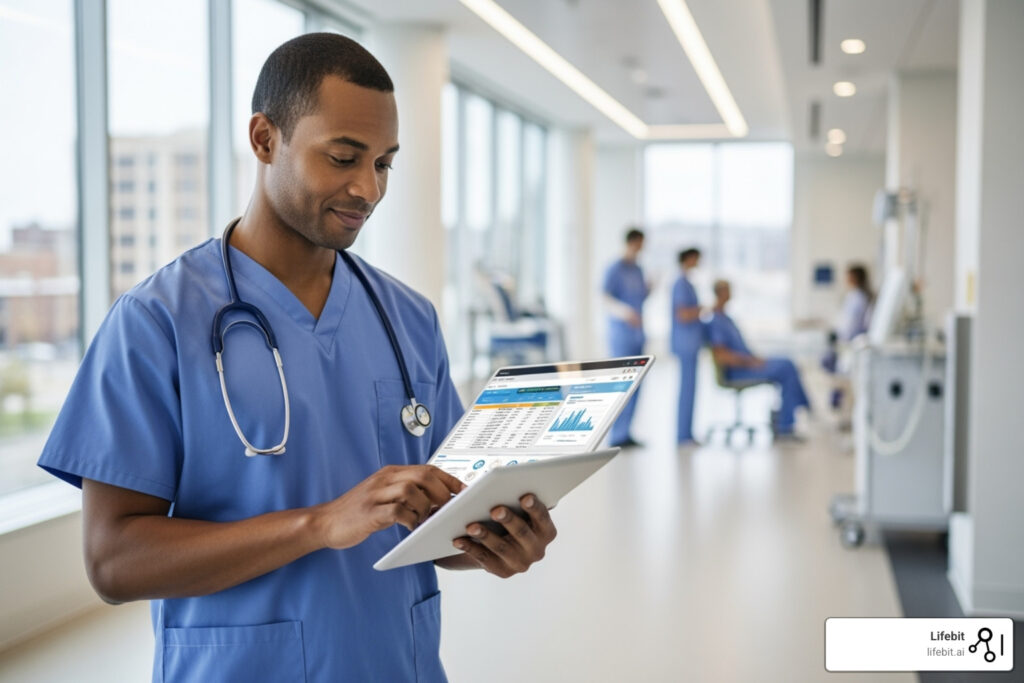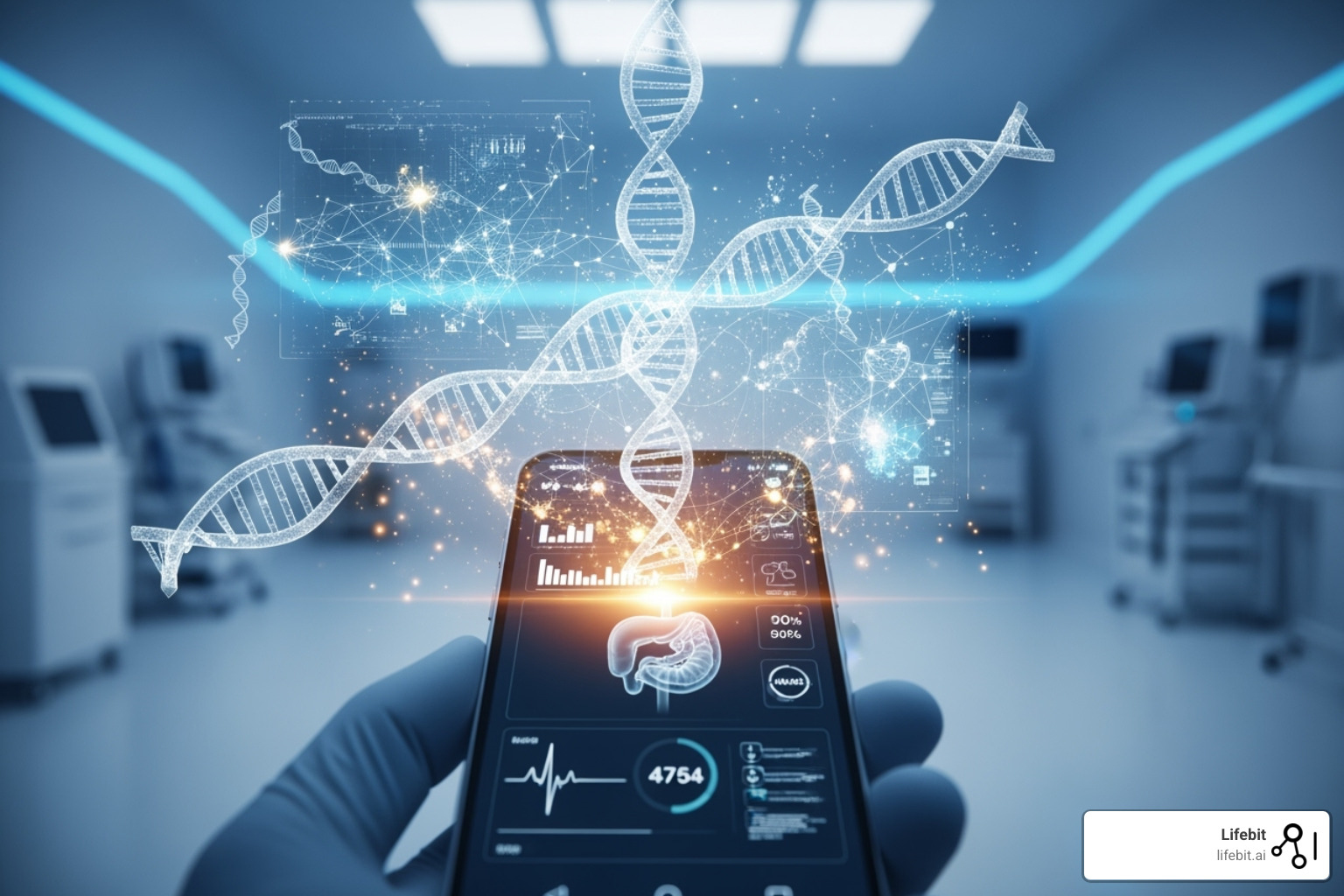The EHR/EMR Jargon Buster: Your Guide to Electronic Medical Record Systems

Electronic Medical Record Systems: 2025 Jargon Buster
Understanding Electronic Medical Record Systems in Healthcare
Electronic medical record systems are digital platforms for storing, managing, and sharing patient health information. These systems have transformed healthcare by replacing paper charts with sophisticated digital platforms that improve care quality and operational efficiency.
What are Electronic Medical Record Systems?
- EMR (Electronic Medical Record): A digital version of paper charts used within a single practice.
- EHR (Electronic Health Record): Comprehensive patient data that can be shared across multiple healthcare providers.
- PHR (Personal Health Record): Patient-controlled health information managed by individuals.
Adoption shows significant benefits, with research indicating a net benefit of $86,400 per provider over five years, and practices recovering implementation costs in just 2.5 years.
However, challenges remain, including initial costs of $44,000 per provider and a 17.5% increase in physician documentation time with some systems. With only 4% of ambulatory physicians having fully functional systems, there is massive growth potential.
This shift is about creating interoperable systems for better patient care, reduced medical errors, and data-driven research to transform global health.
I’m Dr. Maria Chatzou Dunford, CEO and Co-founder of Lifebit. With over 15 years in computational biology and health-tech, I specialize in integrating electronic medical record systems with genomic data. My work focuses on creating secure, federated environments for leveraging EHR data in precision medicine and drug findy.
EMR vs. EHR vs. PHR: Decoding the Acronyms
The acronyms for electronic medical record systems can be confusing. Understanding the differences between Electronic Medical Records (EMR), Electronic Health Records (EHR), and Personal Health Records (PHR) is crucial in today’s digital healthcare landscape.
While all involve digital patient charts, they differ in data sharing and interoperability. The evolution from isolated systems to patient-centric data has transformed healthcare information. Research shows that integrating PHR, EMR and EHR systems drives more personalized healthcare and better public health policy.
Let’s break down what makes each system unique.
Electronic Medical Record (EMR)
An EMR is the digital version of paper charts for single practice use. It contains your medical history, diagnoses, and treatment from that specific practice. However, it’s not easily shared with other providers, which can lead to fragmented care if you see multiple specialists.
Electronic Health Record (EHR)
An EHR is more powerful, providing a comprehensive patient history that is shareable across providers like specialists, hospitals, and labs. This interoperability means your entire care team has up-to-date information, preventing repetitive histories and drug interaction errors. As noted by HealthIT.gov, the advantages of electronic health records include better care coordination, decision-making, and patient safety.
Personal Health Record (PHR)
A PHR is a patient-controlled record managed by the individual. You can input data from various sources, including doctor visits, home monitoring, and fitness trackers, for comprehensive health tracking. As this guide on what is a personal health record explains, PHRs empower you to be an active participant in your care, helping you spot patterns and prepare for appointments.
To help you see these differences at a glance, here’s how these three systems compare:
| Attribute | Electronic Medical Record (EMR) | Electronic Health Record (EHR) | Personal Health Record (PHR) |
|---|---|---|---|
| Data Content | Digital chart for a single practice/clinic, medical history, diagnoses, treatments | Comprehensive, longitudinal patient health information from all providers | Patient-entered data, summaries from providers, health tracking |
| Who Creates/Manages It | Healthcare providers within a specific practice | Healthcare providers across multiple organizations, often institution-managed | The individual patient |
| Interoperability | Generally limited to the single practice; not designed for external sharing | Designed for seamless sharing and communication across healthcare entities | Managed by patient, can integrate data from various sources if allowed |
| Primary Use Case | Clinical documentation and workflow within a single provider’s office | Coordinated, holistic patient care across the entire healthcare ecosystem | Personal health management, tracking, and engagement |
When EMRs, EHRs, and PHRs integrate effectively, patients get better care, providers make more informed decisions, and researchers gain valuable insights.
The Impact of Electronic Medical Record Systems on Healthcare
The shift to electronic medical record systems has transformed healthcare. More than digital filing cabinets, these systems improve patient safety, workflow efficiency, data accuracy, and overall quality of care. By replacing paper files, they eliminate issues like illegible handwriting and provide clinical decision support with evidence-based guidance.
Benefits for Providers and Patients
For providers, electronic medical record systems offer instant access to comprehensive patient histories, lab results, and imaging, changing diagnostics and eliminating delays.
A key advantage is the dramatic reduction in medical errors. EMRs eliminate risks from illegible handwritten prescriptions, and built-in safety checks can reduce medication administration errors by 55-83%.
Financially, a cost-benefit analysis shows a net financial benefit of $86,400 per provider over five years. Practices typically recover their investment in just 2.5 years through savings and better charge capture.
For patients, benefits include better care coordination, which reduces the need to repeat medical histories and undergo duplicate tests. Access to patient portals increases engagement. Research shows practices using EHRs provide higher quality care because doctors have complete information and decision support tools.
Here are the top 5 benefits of EHR adoption:
- Improved Patient Safety: Eliminated prescription errors and crystal-clear records
- Better Care Coordination: Seamless information sharing among all your healthcare providers
- Increased Efficiency: Streamlined tasks, fewer duplicate tests, faster access to information
- Improved Patient Engagement: Direct access to your own health records and test results
- Superior Quality of Care: Comprehensive data and smart alerts help doctors make better decisions
Challenges and Barriers to Adoption
Despite the benefits, adoption faces problems, especially for smaller practices. The primary barrier is cost. The initial investment averages $44,000 per provider, with an additional $8,500 annually for maintenance. These figures can be overwhelming for practices on thin margins.
Usability issues are another challenge. Clunky systems can increase physician documentation time by 17.5% or more, leading to less patient interaction and contributing to physician burnout.
The transition process is also daunting. It involves converting paper records and redesigning established clinical workflows. As a systematic review on EHR tensions and paradoxes notes, this can disrupt routines and temporarily affect patient care.
Data security concerns create psychological barriers to adoption, as providers are responsible for protecting sensitive patient information in a connected world.
Key Features of Modern Electronic Medical Record Systems
Today’s electronic medical record systems are sophisticated platforms designed to improve healthcare delivery.
- Patient portals are game-changers for engagement, allowing patients to view results, schedule appointments, and communicate with their care team 24/7.
- E-prescribing sends prescriptions directly to pharmacies, reducing errors and creating a complete, portable medication history.
- Clinical Decision Support (CDS) tools provide real-time, evidence-based alerts for drug interactions, preventive screenings, and treatment guidelines.
- Computerized Provider Order Entry (CPOE) allows direct entry of medical orders (meds, labs, imaging), eliminating transcription errors and improving accuracy.
- Integration with practice management software streamlines administrative tasks like scheduling and billing.
- Reporting and analytics capabilities transform data into actionable insights for quality measurement and population health initiatives.
Advanced technologies like Natural Language Processing (NLP) and machine learning are being integrated to analyze notes and predict outcomes. With 62.6% of providers using mobile devices, mobile EMR access is also becoming standard.
Security, Privacy, and Interoperability

Electronic medical record systems handle highly sensitive health data. The shift from paper to digital creates responsibilities for security, privacy, and interoperability. This requires balancing protection with accessibility through robust, well-planned systems.
Ensuring Data Privacy and Security
Protecting patient data is fundamental to maintaining trust in healthcare. Modern systems use layered protection. Access controls limit information to authorized personnel, while audit trails log every access. Encryption scrambles data during storage and transmission, and secure networks with firewalls provide further defense.
Staff training is critical, as human factors are key to security. Training covers phishing, password best practices, and confidentiality.
For research, anonymization and pseudonymization techniques remove personal identifiers from data, allowing for valuable insights without compromising privacy.
These measures operate under strict regulations like HIPAA in the US. Despite robust protections, the threat of data breaches requires constant vigilance and updates, making security an ongoing commitment.
The Role of Government and Standards
Government initiatives have been crucial in promoting secure, interoperable electronic medical record systems. The 2009 HITECH Act provided $34 billion in incentives and established Meaningful Use requirements to ensure effective EHR adoption.
Interoperability—getting different systems to communicate—has been a major challenge. Standards bodies like CCHIT and technical standards like Fast Healthcare Interoperability Resources (FHIR) have been developed to create a common language for data exchange.
As research on harmonizing standards for interoperability notes, common standards are vital for overcoming legal complexities in cross-border data sharing. At Lifebit, our federated AI platform builds on these standards, enabling secure, large-scale research across jurisdictions while respecting regulatory frameworks.
Patient Access to Health Records
A key benefit of modern electronic medical record systems is patient access to their own health information. When patients view their records, they become more engaged in their care, can spot errors, and better coordinate their care. Research shows this access can lead to improved health outcomes.
Challenges include varying health literacy, as medical terms can be confusing without context. The digital divide also creates disparities, as not everyone has reliable internet or technical skills.
Legislation like the 21st Century Cures Act mandates greater patient access to health information, including clinical notes, to make patients true partners in their care.
The key is balancing meaningful access with the context and support patients need. When done well, patient access transforms the doctor-patient relationship into a true partnership.
The Future of Electronic Health Records

The world of electronic medical record systems is evolving from digital charts to intelligent systems that predict health problems and improve clinical decisions. Future records may warn of heart attack risks or automatically match patients to clinical trials. This isn’t science fiction; it’s the emerging reality in healthcare.
The Future of Electronic Medical Record Systems: Trends and Innovations
The next wave of electronic medical record systems is powered by AI, machine learning, and big data analytics, which are fundamentally changing healthcare.
- AI-driven diagnostics are showing remarkable results. Deep learning models analyze EHR data to predict mortality risk, helping doctors prioritize care. AI also improves disease screening by combining data types to detect conditions like cancer earlier.
- Natural Language Processing (NLP) is a game-changer, open uping valuable information from free-text clinical notes to find patterns and insights.
- Digital twins are a fascinating development. A virtual copy of a patient, built from EHR data, genetics, and wearables, could test treatments virtually. As explored in Healthcare 4.0: A review of frontiers in digital health, this is a leap toward personalized medicine.
- Cloud-based EHRs are removing technical barriers, allowing secure data sharing between providers so the entire care team has a complete picture.
- Mobile device integration is also key. With over 60% of providers using mobile devices, they can access records on the go. Data from patient wearables can also flow into the EHR, providing a richer health picture.
At Lifebit, we pioneer federated data platforms that allow researchers to analyze global health data without moving it. Our Trusted Research Environment (TRE), Trusted Data Lakehouse (TDL), and R.E.A.L. layer enable breakthrough findies while ensuring patient privacy.
EHR’s Role in Research and Public Health
When electronic medical record systems become research tools, every data point contributes to a vast database that can help cure diseases.
Medical research is revolutionized by EHR data. Researchers can analyze existing records from thousands of patients, dramatically speeding up findy, as detailed in this research on using EHRs for clinical research.
Population health management benefits greatly from EHRs. Officials can spot outbreaks, track vaccination rates, and identify health trends. During the COVID-19 pandemic, EHR data was crucial for hospital preparedness and research.
Other key areas transformed by EHR data include:
- Clinical trial matching: AI algorithms scan EHRs to connect eligible patients with experimental treatments.
- Pharmacovigilance: Post-market drug safety monitoring is improved by automatically detecting safety signals.
The scope of research is remarkable, covering canine cancer, antimicrobial resistance, diabetes, HIV/AIDS, asthma, and cardiovascular disease. This is possible by securely analyzing massive, diverse datasets. Our federated approach at Lifebit enables researchers to gain insights from global real-world data while sensitive information remains secure. It’s collaboration without compromise, essential for the future of healthcare research.
Frequently Asked Questions about Electronic Medical Record Systems
Navigating electronic medical record systems can be complex. Here are answers to some of the most common questions from providers and patients.
How much do EMR systems typically cost?
The financial investment is a primary concern for practices. Initial costs for a full-time equivalent provider average $44,000, covering software, hardware, installation, and training. Annual ongoing costs average $8,500 per provider for maintenance, support, and updates.
Encouragingly, research shows the average practice recovers its EHR investment in just 2.5 years. Returns come from improved efficiency, fewer billing errors, and better charge capture.
Are electronic health records secure?
Yes. Modern EHR systems use multiple layers of protection, often exceeding the security of paper records. Key safeguards include:
- Regulatory frameworks like HIPAA in the US and GDPR in Europe create comprehensive rules for protecting health data.
- Technical safeguards like encryption for data in transit and at rest, and role-based access controls to limit who can view specific information.
- Audit trails log all access to patient records for accountability.
- Administrative safeguards like regular staff training on privacy policies and security risk assessments.
While no system is foolproof, security measures are robust and constantly evolving. Lifebit’s federated platforms are designed with security as a core principle, ensuring HIPAA and GDPR compliance.
Can I access my own electronic medical record?
Yes, accessing your own health records is your right as a patient. The most common method is through secure patient portals, where you can view your medical history, lab results, medications, schedule appointments, and message your care team.
Your legal rights are protected by laws like the 21st Century Cures Act in the US, which guarantees access to your electronic health information. While challenges like confusing medical terminology and the digital divide exist, the trend is toward greater transparency, as engaged patients often have better health outcomes.
Conclusion
Our exploration of electronic medical record systems shows a change from digital files to a reimagining of how we use health information, from basic EMRs to AI-driven healthcare.
The distinctions are crucial: EMRs serve individual practices, EHRs enable coordinated care with shareable records, and PHRs empower patients by giving them control over their health data.
The benefits—improved patient safety, better care coordination, and vast research potential—are real, but so are the challenges of cost, usability, and data security.
The evolution towards data-driven healthcare is exciting. We are moving to a future where artificial intelligence analyzes patterns, machine learning predicts health outcomes, and digital twins enable personalized medicine.
The future promises greater integration of predictive analytics, mobile health, and federated platforms that enable secure, global research collaboration.
At Lifebit, we know that open uping the potential of EHR data requires secure, interoperable systems. Our federated AI platform provides secure, real-time access to global biomedical data for large-scale research. We create Trusted Research Environments where advanced analytics deliver real-time insights to improve patient outcomes. The change of healthcare through better data is happening now.
The journey from paper charts to intelligent, interconnected health systems has been remarkable. But we’re just getting started. Learn how federated data platforms are revolutionizing healthcare research and find what’s possible when we combine the power of electronic medical record systems with cutting-edge AI and secure collaboration.

